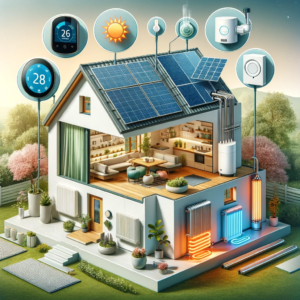Energy-Efficient Heating Options
 With rising energy costs and growing environmental concerns, choosing the right heating system isn’t just about comfort—it’s about responsibility and efficiency.
With rising energy costs and growing environmental concerns, choosing the right heating system isn’t just about comfort—it’s about responsibility and efficiency.
Energy efficiency in heating systems is vital for several reasons:
- Efficient systems consume less energy, reducing your utility bills significantly. This is especially important during winter when heating demands peak.
- Energy-efficient heating solutions have a lesser environmental impact. By consuming less energy, these systems reduce greenhouse gas emissions, contributing to the fight against climate change.
Selecting the appropriate heating system for your home is not a one-size-fits-all solution, but the right system will not only provide sufficient warmth but also do so without wasting energy.
Understanding Energy Efficiency in Heating
Energy efficiency in heating systems refers to the amount of heating provided relative to the energy consumed. A highly efficient system delivers maximum heat with minimal energy input, reducing both costs and environmental impact.
The Benefits of Energy-Efficient Heating Systems
The advantages of choosing an energy-efficient heating system are manifold. Let’s delve into a few key benefits:
- Cost Savings: Perhaps the most immediate benefit of an energy-efficient system is the reduction in utility bills. Efficient systems use less energy to produce the same amount of heat, meaning you pay less over time.
- Environmental Impact: Reducing energy consumption directly correlates with lowering carbon emissions. By opting for an efficient heating system, you’re playing a crucial part in the global effort to combat climate change.
- Enhanced Comfort and Consistency: Efficient systems often provide more consistent and comfortable heat distribution, ensuring your living space remains warm and cozy throughout the colder months.
Understanding Efficiency Metrics: AFUE and SEER Ratings
To help consumers understand and compare the efficiency of heating systems, several key metrics are used. Two of the most common are:
- AFUE (Annual Fuel Utilization Efficiency): This metric, expressed in percentages, measures how efficiently a furnace converts fuel into heat over a year. For example, an AFUE rating of 90% means that 90% of the fuel is converted into heat, with only 10% lost.
- SEER (Seasonal Energy Efficiency Ratio): While SEER is more commonly associated with cooling systems, it’s also relevant for heat pumps, which provide both heating and cooling. SEER measures the ratio of cooling output to electrical energy input over a typical cooling season.
Types of Energy-Efficient Heating Systems
Each system has its own set of advantages and working principles. Let’s delve into some popular options:
Geothermal Heat Pumps
- How They Work: Geothermal heat pumps utilize the stable temperature of the earth as a heat source in winter and a heat sink in summer. They involve circulating a fluid through pipes buried in the ground to absorb or dissipate heat.
- Pros: Extremely efficient, lower operating costs, environmentally friendly, and have a long lifespan.
- Cons: High initial installation cost and the need for sufficient land for the ground loop system.
Solar Heating Systems
- How They Work: These systems convert sunlight into heat energy, typically using solar panels installed on your roof.
Pros: Utilize a free and renewable energy source, have low operating costs, and reduce carbon footprint.
Cons: Depend on sunlight availability, require a significant initial investment, and often need a backup system for cloudy days.
High-Efficiency Furnaces and Boilers
- How They Work: These are upgraded versions of traditional systems, designed to extract more heat from the fuel, often reaching efficiencies over 90%.
- Pros: More efficient than standard models, reduce energy bills and emissions.
- Cons: Higher upfront cost and may require upgrading ductwork or ventilation systems.
Heat Pumps (Air-Source and Water-Source)
- How They Work: Air-source heat pumps extract heat from the outside air, even in cold temperatures, while water-source heat pumps use nearby water bodies as a heat exchange medium.
- Pros: More efficient than conventional heating systems, can provide both heating and cooling, and have lower running costs.
- Cons: Air-source pumps are less effective in extremely cold climates, and water-source pumps require proximity to a water body.
Biomass Heating Systems
- How They Work: These systems burn organic materials, like wood pellets, chips, or logs, to produce heat.
- Pros: Utilize renewable resources, carbon-neutral, and can be cost-effective, especially in areas with abundant biomass.
- Cons: Require storage space for the fuel, regular cleaning and maintenance, and have a higher level of emissions than other renewable systems.
Each of these systems offers a unique approach to heating your home efficiently and sustainably.
When choosing the right system, consider factors like your local climate, home size, and initial budget to find the best fit for your needs.
Factors to Consider When Choosing a Heating System
Selecting the right heating system for your home involves more than just picking the most energy-efficient model. Several critical factors need to be considered to ensure you make a choice that suits your specific needs. Here, we discuss the importance of home size, local climate, insulation, initial investment versus long-term savings, and system compatibility.
Home Size, Climate, and Insulation
- Home Size: The size of your home directly influences the capacity of the heating system required. A system too small won’t be effective, while an oversized system can lead to inefficiency and higher costs.
- Local Climate: Your region’s climate is crucial in deciding the type of heating system you need. For instance, homes in extremely cold climates may benefit more from geothermal heat pumps, whereas those in milder climates might find air-source heat pumps sufficient.
- Insulation: Good insulation reduces the heating requirements of your home. Before investing in a new system, it might be wise to improve your home’s insulation, which can allow you to opt for a smaller, more cost-effective heating system.
Initial Investment vs. Long-Term Savings
The upfront cost of a heating system is an important consideration, but it’s equally vital to think about long-term savings. Energy-efficient systems often have a higher initial price tag but can lead to significant savings in energy bills over time. Calculating the payback period – the time it takes for the savings to offset the initial cost – can help in making an informed decision.
Compatibility with Existing Systems
If some components of a heating system in place, it’s essential to consider how a new system will integrate with these. For instance, if a high-efficiency boiler is being considered, check whether existing radiators and ductwork are compatible. Compatibility not only ensures efficient operation but can also save on the cost of replacing additional parts.
Financial Incentives and Rebates
Investing in an energy-efficient heating system can be financially beneficial, thanks to various incentives and rebates designed to encourage sustainable choices. Understanding these financial perks can significantly offset the initial cost of the investment, making energy efficiency both environmentally and economically appealing.
Types of Financial Incentives
- Government Tax Credits: Many governments offer tax credits for the installation of energy-efficient heating systems. These credits can directly reduce the amount of tax you owe.
- Rebates from Energy Companies: Some local energy companies provide rebates for customers who install energy-efficient systems. These rebates often involve a direct reduction in the purchase price or a refund after purchase.
- Special Financing and Loans: Certain regions offer low-interest loans or specific financing options for energy-efficient home improvements, making upfront costs more manageable.
How to Find Local Rebates and Tax Credits
- Visit Energy Star Website: Energy Star is a trusted resource for finding federal tax credits and rebates on energy-efficient products. Their website lists current incentives and provides details on eligibility and how to apply.
- Check with Local Energy Providers: Your local utility company may have rebate programs. Visit their website or contact them directly to learn about any available offers.
- Consult with Local Government Websites: Many local and state governments have dedicated pages or resources for energy efficiency incentives. They can provide information on regional programs, including tax credits, rebates, and grants.
- Work with Certified Contractors: Certified contractors who specialize in energy-efficient installations are often well-informed about current incentives. They can guide you through the process of selecting a system and applying for rebates.
By taking advantage of these financial incentives, you can not only reduce the cost of installing an energy-efficient heating system but also contribute to a more sustainable future. It’s a win-win situation where the benefits extend beyond just your household.
Conclusion
The journey to select the right heating system is more than a quest for comfort; it is an act of responsibility and a commitment to efficiency. In an era of escalating energy costs and mounting environmental concerns, opting for an energy-efficient heating system becomes not just a choice, but a necessity. These systems, by using less energy to provide the same level of warmth, not only offer significant cost savings but also play a pivotal role in reducing our environmental footprint. They stand as a testament to our ability to balance personal comfort with ecological responsibility.
As we navigate the options available, it’s important to remember that the effectiveness of a heating system is contingent upon various factors such as home size, local climate, and the quality of insulation. This understanding ensures that the selected system is not just efficient but also harmoniously aligned with individual needs.
Moreover, the availability of financial incentives and rebates further sweetens the proposition, making energy-efficient systems a financially viable and environmentally sustainable choice. Ultimately, the decision to adopt such a system is a step towards a future where comfort, cost-effectiveness, and care for the planet coexist in harmony.

 Jacobs and Rhodes
Jacobs and Rhodes Jacobs and Rhodes
Jacobs and Rhodes